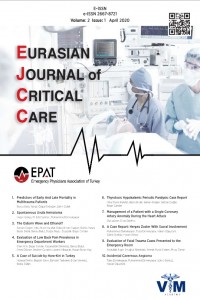Öz
Kaynakça
- Referans 1. Aslar AK, Kuzu MA, Elhan AH, Tanik A, Hengirmen S. Admission lactate level and the APACHE II score are the most useful predictors of prognosis following torso trauma. Injury. 2004;35:746–752. Referans 2. Husain FA, Martin MJ, Mullenix PS, Steele SR, Elliott DC. Serum lactate and base deficit as predictors of mortality and morbidity. Am J Surg. 2003;185:485e491. Referans 3. Martin MJ, FitzSullivan E, Salim A, Brown CV, Demetriades D, Long W. Discordance between lactate and base deficit in the surgical intensive care unit: which one do you trust? Am J Surg. 2006;191:625e630. Referans 4.Li K, Xu Y. Citrate metabolism in blood transfusions and its relationship due to metabolic alkalosis and respiratory acidosis. Int J Clin Exp Med. 2015;8:6578e6584. Referans 5. Gale SC, Kocik JF, Creath R, Crystal JS, Dombrovskiy VY. A comparison of initial lactate and initial base deficit as predictors of mortality after severe blunt trauma. J Surg Res. 2016 Oct;205(2):446-455. doi: 10.1016/j.jss.2016.06.103. Epub 2016 Jul 5. PubMed PMID: 27664895. Referans 6. Neklapilova V, Zelnicek P. Epidemiology of severe injuries from the viewpoint of the trauma center. Cas Lek Cesk 2003;142:676-8. PMid:14689828 Referans 7. Teasdale G, Jennet B . Assesment of coma and impaired consciousness. A practical scale. Lancet 1974:81-84. Referans 8. LichtveldRA,SpijkersAT,HoogendoornJM,Panhuizen IF, van der Werken C. Triage Revised Trauma Score change between first assessment and arrival at the hospital to predict mortality. Int J Emerg Med. 2008 Apr;1(1):21-6. Referans 9. Ibrahim I, Chor WP, Chue KM, Tan CS, Tan HL, Siddiqui FJ, Hartman M. Is arterial base deficit still a useful prognostic marker in trauma? A systematic review. Am J Emerg Med. 2016 Mar;34(3):626-35. doi: 10.1016/j.ajem.2015.12.012. Epub 2015 Dec 14. Review. PubMed PMID: 26856640.
Öz
Trauma-related deaths are the third most common cause of death in all age groups, following cardiovascular diseases and cancer. Predicting mortality and morbidity is of vital importance for patient survival while evaluating trauma patients with a multidisciplinary approach, who account for a significant number of emergency admissions. This study aimed to investigate the parameters that may affect early (<24 hours) and late (>24 hours) mortality due to multitrauma.
The mean RTS of the early deaths (n: 49) was 3.11 ± 2.19 and that of the late deaths was 5.32 ± 1.78; the ratio was statistically significant (p < 0.0001). The mean ISS of the early deaths (n: 49) was 59 ± 17.85 and that of the late deaths was 36.16 ± 12.43; the ratio was statistically significant (p < 0.0001).The mean admission APACHE II score of the early deaths was 27.22 ± 6.78 years; the ratio was statistically significant (p < 0.0001). The mean lactate values were 6.63 ± 3.43 for the early deaths and 3.98 ± 2.87 for the late deaths in late deceased patients and the difference was statistically significant. The mean base deficit (BD) of the early deaths was 11.5 ± 7.06 and that of the late deaths was -5.10 ± 7.15, thereby leading to a statistically significant difference (p < 0.0001).
In conclusion, the GCS score, RTS, ISS, and APACHE II score are reliable to use for mortality prediction and high lactate and BD levels can also be used in early mortality prediction. We believe that aggressive treatment may make a positive contribution to survival in patients with high lactate and BD values.
Anahtar Kelimeler
Kaynakça
- Referans 1. Aslar AK, Kuzu MA, Elhan AH, Tanik A, Hengirmen S. Admission lactate level and the APACHE II score are the most useful predictors of prognosis following torso trauma. Injury. 2004;35:746–752. Referans 2. Husain FA, Martin MJ, Mullenix PS, Steele SR, Elliott DC. Serum lactate and base deficit as predictors of mortality and morbidity. Am J Surg. 2003;185:485e491. Referans 3. Martin MJ, FitzSullivan E, Salim A, Brown CV, Demetriades D, Long W. Discordance between lactate and base deficit in the surgical intensive care unit: which one do you trust? Am J Surg. 2006;191:625e630. Referans 4.Li K, Xu Y. Citrate metabolism in blood transfusions and its relationship due to metabolic alkalosis and respiratory acidosis. Int J Clin Exp Med. 2015;8:6578e6584. Referans 5. Gale SC, Kocik JF, Creath R, Crystal JS, Dombrovskiy VY. A comparison of initial lactate and initial base deficit as predictors of mortality after severe blunt trauma. J Surg Res. 2016 Oct;205(2):446-455. doi: 10.1016/j.jss.2016.06.103. Epub 2016 Jul 5. PubMed PMID: 27664895. Referans 6. Neklapilova V, Zelnicek P. Epidemiology of severe injuries from the viewpoint of the trauma center. Cas Lek Cesk 2003;142:676-8. PMid:14689828 Referans 7. Teasdale G, Jennet B . Assesment of coma and impaired consciousness. A practical scale. Lancet 1974:81-84. Referans 8. LichtveldRA,SpijkersAT,HoogendoornJM,Panhuizen IF, van der Werken C. Triage Revised Trauma Score change between first assessment and arrival at the hospital to predict mortality. Int J Emerg Med. 2008 Apr;1(1):21-6. Referans 9. Ibrahim I, Chor WP, Chue KM, Tan CS, Tan HL, Siddiqui FJ, Hartman M. Is arterial base deficit still a useful prognostic marker in trauma? A systematic review. Am J Emerg Med. 2016 Mar;34(3):626-35. doi: 10.1016/j.ajem.2015.12.012. Epub 2015 Dec 14. Review. PubMed PMID: 26856640.
Ayrıntılar
| Birincil Dil | İngilizce |
|---|---|
| Konular | Acil Tıp |
| Bölüm | Review Article |
| Yazarlar | |
| Yayımlanma Tarihi | 26 Nisan 2020 |
| Gönderilme Tarihi | 27 Ocak 2020 |
| Kabul Tarihi | 27 Şubat 2020 |
| Yayımlandığı Sayı | Yıl 2020 Cilt: 2 Sayı: 1 |


